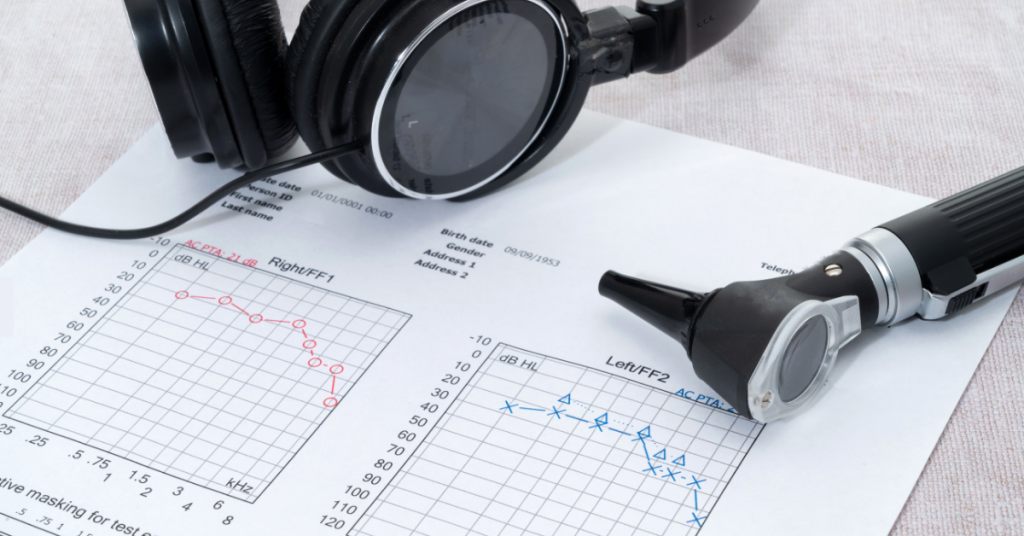Have you ever looked at an audiogram and felt completely lost? You’re not alone. Audiograms — the charts used by audiologists to map your hearing ability — can look like complicated medical diagrams at first glance. But the truth is, with a little guidance, they’re actually quite straightforward and can tell you a lot about your hearing health.
In simple terms, an audiogram is a visual summary of how well you hear different sounds. It’s the result of a hearing test and helps both you and your hearing care professional understand whether you have hearing loss, and if so, how severe it is and which frequencies are affected. Learning to read your audiogram is an empowering step — it puts knowledge in your hands and helps you ask better questions and make more confident decisions about treatment, like whether hearing aids or other interventions might help.
This guide is designed especially for adults over 50, caregivers, and anyone who wants to understand their own or a loved one’s hearing test results. We’ll break down everything from what the graph lines mean to the types of hearing loss they can indicate. By the end of this article, you’ll be able to look at an audiogram and actually understand what it’s telling you — and what to do next.
Let’s dive in and decode the audiogram together.
What Is an Audiogram and Why Is It Important?
An audiogram is a specialized graph used to chart the results of a hearing test, providing a snapshot of your hearing ability across a range of sound frequencies and volumes. It is the gold standard for diagnosing hearing loss and is a crucial tool in the hands of audiologists. But for patients, it’s more than just data—it’s a key to understanding what’s going on with your ears and what steps you can take to improve your hearing health.
The test behind the audiogram, called pure-tone audiometry, measures how well you can hear sounds at different pitches (frequencies) and loudness levels (decibels). During this test, you wear headphones or ear inserts in a quiet room or sound booth. You’ll listen to a series of beeps or tones and indicate when you hear them, usually by pressing a button. The test checks each ear separately, and the results are plotted on your audiogram.
What makes the audiogram important is how clearly it shows the softest sounds you can hear at different pitches — from low bass sounds to high-pitched tones like birds chirping or a tea kettle whistling. This information helps determine:
- Whether you have hearing loss
- How much hearing loss you have
- Which pitches (frequencies) are affected
- Whether one ear hears better than the other
Understanding your audiogram can also help identify the type of hearing loss you may be experiencing — whether it’s conductive (caused by problems in the outer or middle ear), sensorineural (related to inner ear or nerve damage), or a mix of both.
Even more importantly, your audiogram serves as the foundation for personalized treatment plans. Audiologists use it to fit hearing aids, recommend cochlear implants, or guide medical treatment if necessary. For you, it’s a way to track changes in your hearing over time and take charge of your hearing wellness.
In short, the audiogram isn’t just a chart. It’s a window into your hearing health — and learning how to read it is a powerful step toward understanding and improving your quality of life.
Breaking Down the Audiogram Chart: Understanding the Axes and Symbols
When you first see an audiogram, it might look like a tangle of lines and symbols. But once you understand how it’s laid out, the chart becomes much easier to read — and incredibly insightful. Let’s break down its basic structure.
The Axes: What Do They Represent?
An audiogram has two main axes, just like any other graph:
- Horizontal axis (left to right): This represents frequency, or pitch, measured in Hertz (Hz). It starts at the low end (typically 125 Hz) on the left — think deep sounds like thunder — and goes up to high-pitched sounds (8000 Hz or more) on the right, like birds chirping or a phone ringing.
- Vertical axis (top to bottom): This shows intensity, or loudness, measured in decibels hearing level (dB HL). Softer sounds are at the top (0 dB), and louder sounds are at the bottom (going down to 120 dB or more). The further down a mark appears, the louder the sound had to be before you could hear it — which often indicates hearing loss at that frequency.
Key Symbols Used in Audiograms
Audiologists use specific symbols to indicate hearing thresholds — the softest level of sound you can hear at each frequency. These thresholds are tested for each ear separately:
- Right Ear (usually in red):
- O = Air conduction threshold (headphones or inserts)
- < = Bone conduction threshold (vibrating device on the mastoid bone)
- Left Ear (usually in blue):
- X = Air conduction threshold
- > = Bone conduction threshold
Air conduction tests how sound travels through the entire ear, while bone conduction bypasses the outer and middle ear to test inner ear function directly. The comparison helps determine the type of hearing loss.
Connecting the Dots: The Audiogram Lines
Each symbol marks the threshold for a specific frequency. When connected by lines, these points form a visual pattern that audiologists use to interpret hearing health. A flat line near the top of the chart usually indicates normal hearing, while a line that drops lower down the chart shows hearing loss — and how it changes across pitches.
Normal Hearing Range
Typically, thresholds between 0 and 25 dB HL are considered normal hearing for adults. Anything below that — closer to the bottom of the chart — indicates some level of hearing difficulty, depending on how far the line drops.
Understanding the axes and symbols of the audiogram is your first major step in interpreting your hearing test. Once you know what each part means, the chart begins to tell a very personal story — your story.
Types and Degrees of Hearing Loss: What Your Audiogram Can Tell You
Now that you understand how to read the axes and symbols of an audiogram, the next step is learning how to interpret what those marks actually mean. Your audiogram reveals two essential pieces of information: the type of hearing loss you may have and its degree (or severity). Both are key to determining the right treatment and support.
Types of Hearing Loss
There are three primary types of hearing loss that an audiogram can help identify:
1. Conductive Hearing Loss
This type occurs when sound has trouble passing through the outer or middle ear — often due to blockages like earwax, fluid, or structural problems. On an audiogram, this is usually indicated by a gap between the air conduction (O or X) and bone conduction (< or >) thresholds, where bone conduction remains within normal limits. This means the inner ear is working properly, but something is preventing sound from reaching it efficiently.
2. Sensorineural Hearing Loss
This is the most common type, especially in older adults. It occurs when there’s damage to the inner ear (cochlea) or the auditory nerve. The audiogram for sensorineural hearing loss shows air and bone conduction thresholds that are closely aligned, but both are shifted downward (indicating poor hearing sensitivity). There’s no “air-bone gap” because both paths to the inner ear are impaired.
3. Mixed Hearing Loss
As the name suggests, this combines elements of both conductive and sensorineural loss. On an audiogram, there’s typically a gap between air and bone conduction thresholds, but both are below normal levels. This means there’s an issue both in sound transmission and inner ear function.
Degrees of Hearing Loss
The degree of hearing loss is based on how far below the top of the audiogram your hearing thresholds fall. These categories are generally accepted:
- Normal: 0 to 25 dB HL
- Mild: 26 to 40 dB HL
- Moderate: 41 to 55 dB HL
- Moderately Severe: 56 to 70 dB HL
- Severe: 71 to 90 dB HL
- Profound: 91+ dB HL
Each degree affects your ability to hear speech and environmental sounds differently. For example:
- Mild loss may cause trouble hearing soft speech or in noisy environments.
- Moderate to severe loss may mean missing most conversations without hearing aids.
- Profound loss often requires advanced interventions, like powerful hearing aids or cochlear implants.
Understanding What It Means for You
Your audiogram gives you a roadmap. Knowing whether your hearing loss is mild or profound, and whether it’s sensorineural or conductive, helps determine your treatment options. Hearing aids, assistive devices, or even medical or surgical solutions might be recommended depending on the audiogram findings.
Most importantly, identifying the type and degree of hearing loss early can significantly improve your long-term outcomes. That’s why understanding your audiogram is not just informative — it’s empowering.
Common Audiogram Patterns and What They Mean
As you learn to interpret an audiogram, one of the most insightful elements to observe is the overall shape or pattern of the plotted thresholds. These patterns often provide important clues about the cause of hearing loss and how it affects your daily life. Audiologists are trained to recognize these trends and connect them to common auditory conditions. Here’s a look at some of the most recognizable audiogram patterns — and what they might mean.
Ski-Slope Hearing Loss (High-Frequency Loss)
This is one of the most common patterns, especially in older adults. It’s characterized by normal or near-normal hearing at low frequencies (left side of the graph), with thresholds dropping sharply at higher frequencies (right side).
What it suggests:
- Age-related hearing loss (presbycusis)
- Noise-induced hearing loss
- Ototoxic medication effects
How it feels:
- Voices may sound muffled or unclear, especially women’s and children’s voices
- Difficulty understanding speech in noisy environments
- Trouble hearing high-pitched sounds like birds or alarms
Flat Hearing Loss
In this pattern, thresholds are relatively even across all frequencies, but shifted downward, indicating the same level of hearing loss at both low and high pitches.
What it suggests:
- Genetic hearing loss
- Middle ear disorders (like otosclerosis)
- Long-term exposure to moderate noise
How it feels:
- Speech sounds softer overall
- May still understand speech if it’s loud enough
- Often benefits well from hearing aids
Reverse-Slope (Rising) Hearing Loss
This rarer pattern shows better hearing in high frequencies and poorer hearing in low frequencies — the opposite of the ski-slope.
What it suggests:
- Genetic conditions (like Wolfram syndrome)
- Ménière’s disease (especially in early stages)
- Eustachian tube dysfunction
How it feels:
- Difficulty hearing deep voices (like adult males)
- Trouble with low-pitched environmental sounds (e.g., thunder, engines)
- Speech understanding may be relatively good
Cookie-Bite or U-Shaped Hearing Loss
Thresholds dip in the mid-frequencies and rise again at the low and high ends, creating a “U” or “cookie-bite” shape.
What it suggests:
- Often genetic and progressive
- Sometimes seen in younger individuals
- May worsen over time
How it feels:
- Trouble understanding speech, especially in group settings
- Hearing seems inconsistent — some sounds are clear, others are missing
- May go unnoticed until moderate stages
Notched Hearing Loss
This pattern shows a sharp dip (or “notch”) in hearing sensitivity at one frequency range, often around 4000 Hz.
What it suggests:
- Noise-induced hearing loss (e.g., from loud music, gunfire, machinery)
How it feels:
- High-frequency sounds are less clear
- May still hear speech but have difficulty with clarity
- Early intervention with hearing protection can prevent worsening
Recognizing these common audiogram patterns can provide context for your hearing experience. But remember — while patterns offer clues, only a trained hearing care professional can make a complete diagnosis and recommend the best next steps.
Next Steps After Reading Your Audiogram
Understanding your audiogram is a powerful first step—but what you do with that knowledge is just as important. Whether your results show normal hearing, mild loss, or something more significant, your next steps can make a big difference in your quality of life. Here’s how to move forward with confidence and support.
1. Review Results with a Hearing Care Professional
An audiogram is only part of the picture. It’s crucial to discuss your results with an audiologist or hearing specialist who can:
- Explain your specific type and degree of hearing loss in plain language
- Connect the results to your symptoms (like difficulty hearing in crowds or when watching TV)
- Recommend appropriate next steps based on your lifestyle, goals, and health
Even if your hearing loss appears minor, a professional interpretation can uncover important details or trends.
2. Consider Hearing Aids or Assistive Devices
If your audiogram shows mild to profound hearing loss, hearing aids or other devices may be recommended. Your audiologist will guide you through:
- The best hearing aid styles for your type of loss
- Features like noise reduction, Bluetooth connectivity, or rechargeability
- Custom programming based on your audiogram results
Early adoption of hearing aids is shown to support better long-term hearing outcomes and even cognitive health in older adults.
3. Explore Additional Testing or Medical Referrals
In some cases, your audiogram may indicate the need for further evaluation. For example:
- Asymmetrical hearing loss (one ear worse than the other) may require imaging to rule out nerve or brain-related issues
- Sudden hearing loss may be a medical emergency and needs prompt treatment
- Conductive hearing loss might be treatable with medication or surgery
Your audiologist can refer you to an ENT (ear, nose, and throat doctor) if medical issues are suspected.
4. Protect Your Hearing Moving Forward
Whether or not you need hearing aids, protecting your remaining hearing is vital. Tips include:
- Wearing earplugs in noisy environments
- Turning down headphone and TV volumes
- Taking listening breaks if exposed to prolonged loud sounds
- Monitoring changes in your hearing with regular checkups
5. Share Your Results with Family or Caregivers
If you’re a caregiver or support person for someone with hearing loss, reviewing the audiogram together can help you better understand their needs. It also opens the door to important conversations about hearing strategies, devices, and daily support.
Your audiogram is more than just a test result — it’s a tool for taking charge of your hearing health. By partnering with a professional and staying proactive, you can take meaningful steps toward clearer communication, better relationships, and improved quality of life.
Conclusion
Reading an audiogram doesn’t have to be intimidating. With a basic understanding of how the chart works — from its axes and symbols to the patterns it reveals — you gain a clearer picture of your hearing health. Whether you’re just curious about a recent hearing test or navigating the next steps after a diagnosis, this knowledge puts you in control.
Your audiogram is a unique visual representation of how you hear the world. It can tell you what frequencies are affected, how severe the loss is, and what type of hearing issue you might be dealing with. Most importantly, it lays the foundation for a personalized treatment plan that can improve your ability to connect, communicate, and enjoy life more fully.
If you haven’t already, schedule a time to go over your audiogram with a licensed hearing care provider. They can translate the data into real-world meaning and help you explore solutions that are right for your needs — whether that means hearing aids, medical treatment, or simple lifestyle adjustments.
Understanding your audiogram is the beginning of a journey toward better hearing — and better living. You don’t have to navigate it alone. With the right information and professional guidance, clearer hearing is well within reach.
FAQ
What does 0 dB on an audiogram mean?
0 dB HL (decibels hearing level) on an audiogram doesn’t mean “no sound” — it means that sound is at the softest level that a person with normal hearing can detect. If your hearing thresholds are close to 0 dB across frequencies, that typically indicates normal hearing.
Is it bad if my audiogram shows a slope?
Not necessarily. A sloping pattern, especially at higher frequencies, is common and often associated with age-related or noise-induced hearing loss. What matters more is the degree of the slope and how it affects your ability to hear speech and sounds in daily life. An audiologist can explain its significance and recommend next steps.
Can an audiogram diagnose all types of hearing loss?
An audiogram is very effective in identifying most types of hearing loss, especially sensorineural and conductive types. However, it may not detect all auditory processing issues or the underlying cause of the hearing loss. Sometimes additional tests or medical evaluations are needed.
How often should I get an audiogram?
Adults over 50 should consider a baseline hearing test and then get checked every 1 to 3 years, especially if they notice any changes in their hearing. If you use hearing aids or have known hearing loss, more frequent evaluations may be recommended.
Will hearing aids fix my audiogram?
Hearing aids don’t “fix” your audiogram in the sense of changing your hearing thresholds on paper. Instead, they amplify sounds to help you hear better in everyday situations. Think of them as tools that improve your hearing experience, not as a cure or reversal of hearing loss.






